C.L. Francisco's Blog, page 6
October 22, 2015
Cats of Rekem now available!
Now available!
The Cats of Rekem
Kindle and Paperback!

The Cats of Rekem: The Sequel to Yeshua’s Cat
by C. L. Francisco
“We are the cats of Rekem, descended from the sacred cats of the Egyptian temple of Bast. We bear the Mother’s gift of language, passed down since the days before time began, so that we might speak our wisdom into the minds of the troubled human race. We gather here to honor Yeshua ben Yosef, friend of cats—He Who Brings Life to the Earth—whose light shines upon all flesh, animal and human alike.”
The Cats of Rekem opens in the fabled city of Rekem (Petra, Jordan), capital of ancient Nabataea, destroyed by earthquake and swallowed up by desert sands long ago. Francisco brings Rekem to swirling, glittering life, in a kaleidoscopic pageant of exotic characters from a lost culture that reached its peak during the days of Jesus of Nazareth. On the fringes of Rekem’s urban clamor, cats quietly sun themselves, eavesdropping and speaking their thoughts into human minds as the need arises.
25 years have passed in Rekem since the child Yeshua’s rescue (in A Cat Out of Egypt) by Zaidan, a powerful caravan master, and Tikos, an Egyptian priestess fleeing Egypt with a pregnant temple cat from Bubastis. Tikos and Zaidan have married. The Egyptian cats have interbred with wild cats from the hills, and their descendants settled throughout the city with their chosen humans.
In an age of relentless empire building, the independent Nabataeans stubbornly hold to their own traditions, defying the advancing Roman Empire and Israel’s grasping Herod Antipas. Yet Rekem is increasingly caught up in the tide of strange new religions sweeping through the Roman world. Zaidan, Tikos, and their family worship Yeshua’s One God and cherish ties with the risen Yeshua, but the dark mysteries of Isis seduce their daughter Hinat into the goddess’ temple. When Tikos steps in to protect Hinat, King Aretas is enraged by her insult to the gods who stand behind his throne. All of Zaidan’s clan lie beneath the threat of his simmering wrath.
Into this turmoil stumbles a bemused young Apostle Paul, smuggled out of Damascus by Zaidan’s sons, Yeshua’s cat Mari, and Mary Magdalene. Still reeling from his vision on the Damascus road, Paul is painfully confused about what his new life might be. His arrival in Rekem attracts the palace’s attention, loosing a flood of scandal and violence that endangers everyone around him . . . as well as threatening his own future before it can even begin.
Cats of Rekem ready for release Nov 1!
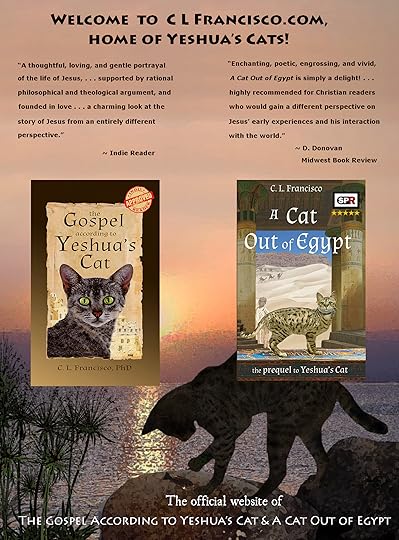
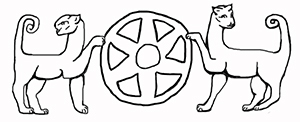
Coming on Amazon November 1, 2015!
The Cats of Rekem
Kindle and Paperback!

The Cats of Rekem: The Sequel to Yeshua’s Cat
by C. L. Francisco
“We are the cats of Rekem, descended from the sacred cats of the Egyptian temple of Bast. We bear the Mother’s gift of language, passed down since the days before time began, so that we might speak our wisdom into the minds of the troubled human race. We gather here to honor Yeshua ben Yosef, friend of cats—He Who Brings Life to the Earth—whose light shines upon all flesh, animal and human alike.”
The Cats of Rekem opens in the fabled city of Rekem (Petra, Jordan), capital of ancient Nabataea, destroyed by earthquake and swallowed up by desert sands long ago. Francisco brings Rekem to swirling, glittering life, in a kaleidoscopic pageant of exotic characters from a lost culture that reached its peak during the days of Jesus of Nazareth. On the fringes of Rekem’s urban clamor, cats quietly sun themselves, eavesdropping and speaking their thoughts into human minds as the need arises.
25 years have passed in Rekem since the child Yeshua’s rescue (in A Cat Out of Egypt) by Zaidan, a powerful caravan master, and Tikos, an Egyptian priestess fleeing Egypt with a pregnant temple cat from Bubastis. Tikos and Zaidan have married. The Egyptian cats have interbred with wild cats from the hills, and their descendants settled throughout the city with their chosen humans.
In an age of relentless empire building, the independent Nabataeans stubbornly hold to their own traditions, defying the advancing Roman Empire and Israel’s grasping Herod Antipas. Yet Rekem is increasingly caught up in the tide of strange new religions sweeping through the Roman world. Zaidan, Tikos, and their family worship Yeshua’s One God and cherish ties with the risen Yeshua, but the dark mysteries of Isis seduce their daughter Hinat into the goddess’ temple. When Tikos steps in to protect Hinat, King Aretas is enraged by her insult to the gods who stand behind his throne. All of Zaidan’s clan lie beneath the threat of his simmering wrath.
Into this turmoil stumbles a bemused young Apostle Paul, smuggled out of Damascus by Zaidan’s sons, Yeshua’s cat Mari, and Mary Magdalene. Still reeling from his vision on the Damascus road, Paul is painfully confused about what his new life might be. His arrival in Rekem attracts the palace’s attention, loosing a flood of scandal and violence that endangers everyone around him . . . as well as threatening his own future before it can even begin.
September 4, 2015
The Cats of Rekem: Coming this fall!
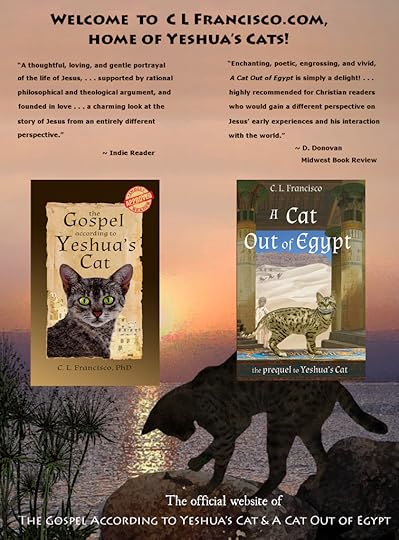
Coming November 1, 2015!
The Cats of Rekem
3rd book in the Yeshua’s Cats series!
The third book in the Yeshua’s Cats series, The Cats of Rekem, will be released on November 1! Joining characters from A Cat Out of Egypt many years later, The Cats of Rekem (or Petra) follows them through Yeshua’s death and resurrection, and into the earliest days of the Apostle Paul’s sojourn in Arabia.

Mark your calendars for Christmas gifts now!
Click here to read more
.
May 5, 2015
The Acts of John, a Gnostic gospel

“Grace dances . . . dance, all of you!”
—The Acts of John
Heresy vs orthodoxy is the stuff that breeds wars, and Church history is full of it. Without getting into a discussion of Church councils and the creation of the Christian canon, I’d like to look at a 2nd C gnostic gospel that was pronounced heretical—and see what it might say to us today.
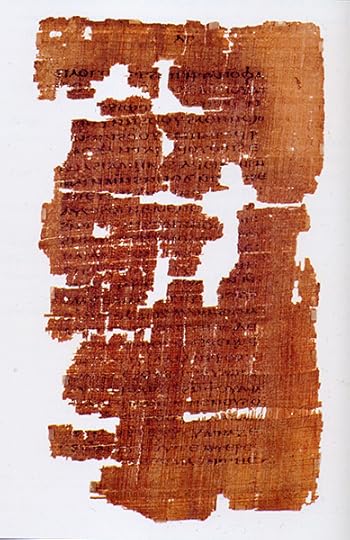
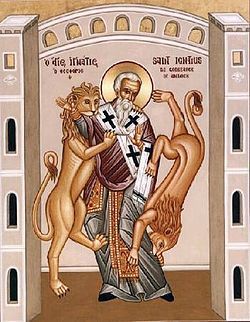
St Ignatius of Antioch, Enemy of Docetism
The Acts of John was condemned by Church fathers as docetic (docetism is the belief that Jesus’ humanity and physical body were an illusion). To modern eyes John can be a peculiar book, full of bizarre notions and unappealing ideas—particularly its contention that the spirit of Christ abandoned the man Jesus to suffer on the cross alone, while the divine essence stood apart, untouched by pain.
But if you can set that notion aside, The Acts of John offers a number of intriguing thoughts. Perhaps most familiar is a lovely passage known as “The Circle Dance of the Cross,” in which, the night before his death, Jesus invites all his disciples to form a circle and dance around him. Those of you who have read Yeshua’s Cat may recognize the last four lines of the quote below as part of Yeshua’s conversation with his mother before he left Nazareth for the last time.

Here is an edited version of the original text:
[Jesus] stood in the circle’s center and said, “Answer ‘Amen’ to everything I say.” Then he began to sing a hymn, saying:
“Glory be to you, Father.”
And we, moving around him in a ring, answered him: “Amen.”
“We praise you, O Father; we give thanks to you, O Light where darkness cannot dwell.”
“Amen.”
“I would be saved, and I would save.”
“Amen.”
“I would be freed, and I would free.”
“Amen.”
“I would be wounded, and I would wound.”
“Amen.”
“I would be born, and I would give birth.”
“Amen.”
“I would eat, and I would be eaten.”
“Amen.”
“I would hear, and I would be heard.”
“Amen.”
“I would be thought of, being wholly thought.”
“Amen.”
“I would be washed, and I would wash.”
“Amen.”
“Grace dances. I would pipe; dance, all of you.”
“Amen.”
“I would mourn: lament, all of you.”
“Amen . . .”
“The Whole on high takes part in our dancing.”
“Amen.”
“Whoever does not dance cannot understand what is coming to pass.”
“Amen.”
“I would flee, and I would stay.”
“Amen.”
“I would adorn, and I would be adorned.”
“Amen.”
“I would be united, and I would unite.”
“Amen . . .”
“A lamp am I to you who behold me.”
“Amen.”
“A mirror am I to you who perceive me.”
“Amen.”
“A door am I to you who knock at me.”
“Amen.”
“A way am I to you a wanderer . . . “
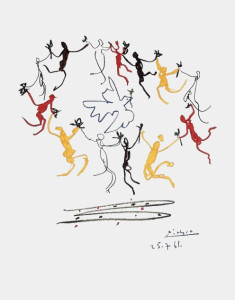
Picasso, “Dance of Youth”
Christian mystics down through the centuries have used the metaphor of dance to describe the human relationship to God, and I found John’s Circle Dance delightful.
Well, I mused, if The Acts of John can include the Circle Dance, what else might I find? So I examined the book more closely. Another idea present throughout the book is that Jesus appeared in many different guises while he walked the earth. I must admit that John’s list allows for a few more possibilities than the canonical gospels: a child, a young handsome man, a youth just bearding, a middle-aged balding man, a small ugly man, a huge heavenly man, a being of whiteness and light, a man with a soft yielding body, a man whose body was hard as stone, a body firm to the touch, and a body with no physical solidity at all. John describes the significance of these guises with the words, “. . . his great grace, his unity that had many faces . . . “
Those words reminded me of recent critics in the search for the historical Jesus who point out that people of every age have tried to mold Jesus into their own ideal of who he should be—thus hopelessly muddying the waters for anyone trying to discern the true historical person.

But here’s my thought: what if Jesus’ message right from the beginning was intended to be a message for all ages and all people? What if his message always had access points that could lead people along diverse paths to the One through him? What if he included embryonic possibilities in his teaching that could support every positive interpretation ever put on his original message? Everything from human rights, the light within, and justice—to caring for the environment and liberation theology? What if most Christian heresies, while diverging from the mainstream, have a unique glimmer of this truth?
Unfortunately, we as humans too often seize on glimmers of truth as if they were the final and complete word of God rather than single facets. Just so the Church has long been at fault for trying to narrow Jesus’ message to fit their limited understanding, enclosing it within a box made to their order. In the hands of the Church, too often the multifaceted diamond of Jesus’ message has been transformed into a stony concretion in crumbling stone—frozen and trapped beneath masses of accumulated tradition.
“His unity that had many faces . . .” is one insight from The Acts of John that we might wish to heed. What if one of Jesus’ primary goals—long obscured by human ignorance—was to bring healing to the shattered images of the One, fragmented for so long among human cultures? What if he offered freedom, and the brilliant unity of God’s countenance, to all people—and we have warped them instead into shadow and condemnation?
Just a thought.

Photo from thefreedomexperiment.com
.
.
March 16, 2015
The Pyramid of the Bush King

.
During the years after the wildfire, when I was first experimenting with possibilities for Yeshua’s Cat, I was living in New Mexico, in the foothills of the Sangre de Cristo Mountains, where the most common views were of low hills covered with Piñon-Juniper woodlands and sagebrush. Inspired by one such hill with an unusually clear pyramidal shape, I wrote an odd little preface for Yeshua’s Cat (that I never used) called “The Pyramid of the Bush King.” I came across it recently among some old files, and thought my readers might enjoy it. Just treat it as a fable, or perhaps a fairy tale . . .
 .
.
.  .
.
Not so very long ago, nor so very far away, in a land much like other lands, a people lived in the shelter of a great mound. Those whose mothers and fathers had dwelt long beneath its shadow spoke of it as the Pyramid of the Bush King, an ancient monument erected to honor the memory of a glorious king. For uncounted generations their forebears had venerated this king as their ancestral guide. But as lifetimes flowed by, the details of the great monarch’s reign grew blurred, and a select group of elders took over the recitation of his deeds.
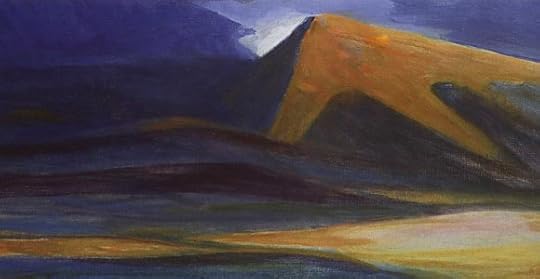
The Earth turned, and the world changed around the people of the Pyramid. Outsiders came and went, chattering excitedly about amazing new discoveries about their king, but the folk of the pyramid resolutely closed their ears and held to their old ways.

Then explorers digging down through crumbling ruins near the mound unearthed an older story, one both greater and smaller than the familiar tale. This story spoke of a mountain never raised by human hands. Rather than a temple to the great king, the hill was as old as Creation itself, worn down by the cycling seasons to its now-familiar pyramidal shape. The stunted bushes that had leant their name to the vanished king had once spread their branches above the heads of men—small trees, but graceful, fruit-bearing, generous in shade, their rustling leaves bending down to touch the fertile earth.
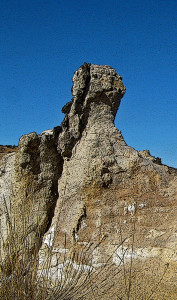 Last, and strange beyond the power of words to tell, the explorers discovered that the mighty king had been no king at all. He had never claimed royal estate, never laid down laws, nor even worn a golden crown. He had laughed and loved, taught and died—and some said lived again—a man beloved of many, yet never a ruler. His glowing words (long treasured through the ages) had somehow lost their fire in the elders’ keeping. And, sadly, as the people of the pyramid had crouched protectively over increasingly vague memories of their king, the trees had shriveled, the green mound had turned to dust, and the world had forgotten his wisdom.
Last, and strange beyond the power of words to tell, the explorers discovered that the mighty king had been no king at all. He had never claimed royal estate, never laid down laws, nor even worn a golden crown. He had laughed and loved, taught and died—and some said lived again—a man beloved of many, yet never a ruler. His glowing words (long treasured through the ages) had somehow lost their fire in the elders’ keeping. And, sadly, as the people of the pyramid had crouched protectively over increasingly vague memories of their king, the trees had shriveled, the green mound had turned to dust, and the world had forgotten his wisdom.
“Listen,” the explorers cried to the mountain people, “we have news of your king! Good news! His words still burn with living fire!” But the old familiar story closed in like a fog on the people’s minds. It lay like pre-dawn mist on autumn fields, whispering of winter light and a sun too weak to pierce their clouded thoughts. So their story of the Bush King endured, unchanging, unending, its tired light casting grey shadows across their bleak lives.

Yet the story is still born anew—and forever old—to any who will look beyond the tattered veils of sadness toward the light. As long as the grasses grow and the rivers run, the king’s light will beckon us home. The Gospel According to Yeshua’s Cat is one voice reaching for the coming of that light.

.
.

.
.

March 3, 2015
Yeshua’s Cat Audiobook Giveaway!

.
Announcing a Giveaway of 10 downloads
of the audiobook of the Gospel According to Yeshua’s Cat!
.
Author C.L. Francisco narrates the unabridged version of Yeshua’s Cat.
Listening time 6 hours, 7 minutes
To enter, just click on the ad above to go to our contact page,
and follow the directions there.
.
Hurry and enter today!
Entries close March 31st!
February 15, 2015
New: The Cats of Rekem
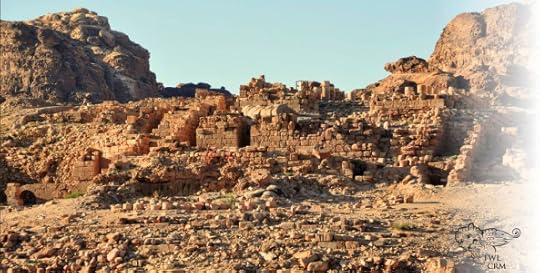
Temple of Winged Lions, photo TWLCRM
The Yeshua’s Cats website has a new page today: the prologue and first chapter of The Cats of Rekem, third book in the Yeshua’s Cats series! If all goes well, The Cats of Rekem will be released in the fall of 2015.
Below is a rough sketch of one of the carvings in the Temple of the Winged Lions at Petra:
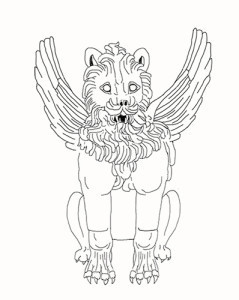
sketch by CL Francisco
.
.
The Cats of Rekem

Temple of Winged Lions, photo TWLCRM
The Yeshua’s Cats website has a new page today: the prologue and first chapter of The Cats of Rekem, third book in the Yeshua’s Cats series! If all goes well, The Cats of Rekem will be released in the fall of 2015.
Below is a rough sketch of one of the carvings in the Temple of the Winged Lions at Petra:

sketch by CL Francisco
.
.
January 25, 2015
Yeshua and the Mystery Religions

Anyone who has studied the history of religions is aware of the shift in human consciousness that began sometime in the last millennium BCE and lasted into the early centuries of the Common Era. During those years human religious practice moved dramatically away from old communal forms and took on more personal expression. Individual human beings began to approach their gods in increasingly distinctive ways, and more and more spiritual teachers emphasized the value of individual human lives. Even C. G. Jung tried to explain the phenomenon in his Psychology and Religion West and East.

Ancient Sumerian gods
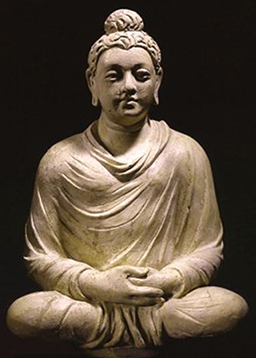
Buddha
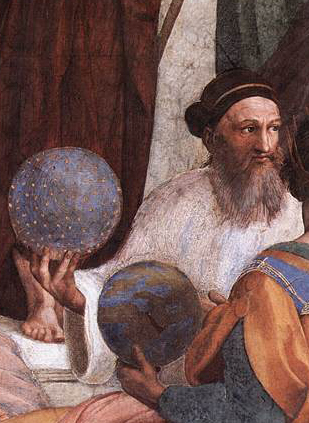
Zarathustra
In India the sage Siddhartha Gautama, later known as the Buddha, offered seekers a Middle Way to enlightenment between the extremes of asceticism and worldly sensuality. In Persia Zarathustra introduced the idea of the freedom of individual human beings and the importance of their choosing to labor with the God of Light, Ahura Mazda, against the forces of darkness and ignorance.
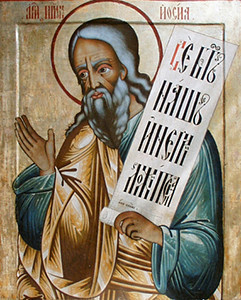
Prophet Hosea
In Israel the prophets emerged, offering ethical virtues such as compassion and mercy as alternatives to the old sacrificial system; Hillel the Elder followed in the 1st C BCE with his Golden Rule, and his famous statement that “whosoever destroys a soul, it is considered as if he destroyed an entire world, and whosoever saves a life, it is considered as if he saved an entire world.”
Jesus of Nazareth, born around 4 BCE, brought a unique gospel of love and life to humankind, known for two millennia as Christianity.
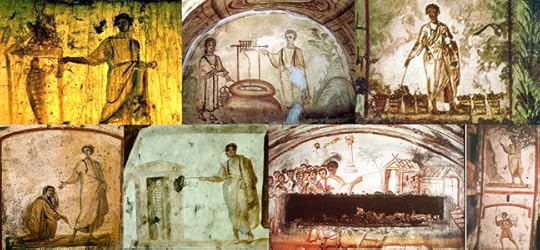
Early catacomb images of Jesus performing miracles
All around Jesus, throughout the ever-spreading Roman Empire, Mystery Religions were attracting followers by the tens of thousands. In each of these Mysteries, individual men and women found hope of eternal life through initiation into secret knowledge unavailable to those outside their communities. Dionysian, Eleusinian, Cybeline, Isaic, Mithraic, and Orphic mysteries were but some of them. In many instances the secret knowledge was imparted through the initiate’s participatory experience in the death and rebirth of the god or goddess.
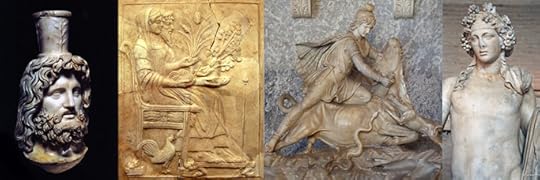
Serapis-Osiris,Persephone and Hades, Mithras, Dionysus
In the process of writing The Cats of Rekem, the third volume in the Yeshua’s Cats series, I wandered into the jungle of Greco-Roman Mystery Religions. I won’t try to offer an explanation of why they exploded into the ancient world, but they were spreading like wildfire across the Mediterranean basin in the years before and after Yeshua’s life. Early Christians were well acquainted with these religions, and in many cases they came to the Church from them.

Dionysian and Eleusinian Mysteries
Numbers of people have written countless volumes of material about the relationship between early Christianity and Mystery Religions, some scholarly and accurate, many biased and inflammatory. As a writer of historical fiction whose characters are rooted in the beliefs of their day, I came up against the question of Mystery Religions in a very personal way. In particular, I found myself needing to understand exactly how Yeshua’s original message differed from the message of the Mysteries. And I didn‘t want to expound the same old Christian apologetics and bland assurances that no overlap ever existed. It obviously did.
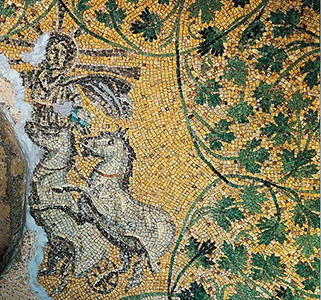
Christ as Sol Invictus (unconquered sun), mosaic from 3rd C Vatican grottoes
So I dusted off my books on Greco-Roman culture and began to refresh my memory. I took notes, and made charts. I even drew up a spreadsheet. I concluded that there were many, many apparent similarities between the practices of the early Church and the Mystery Religions; in fact, there were far more similarities than differences—baptism, equality of men and women, depictions of mother and child, separation of the community from the wider society, hope of immortality through the death and resurrection of a god or founder, ritual commemoration of that same founder’s death and resurrection. The list goes on and on.
But this left me with two troublesome questions. First, did these obvious similarities in the early Church really reflect Yeshua’s message? And second, allowing for the possibility that they might not, how did Yeshua’s message itself differ from the Mysteries? I even went so far as to wonder what he might have said to one of the Mystery devotees that surely crossed his path.
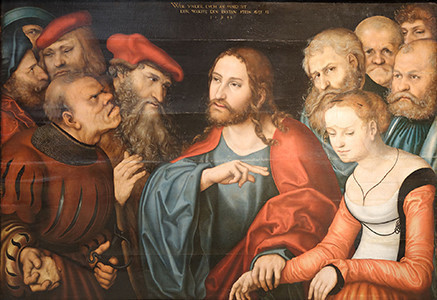
“Christ and the Adulteress,” Cranach the Elder
In the end I isolated several radically new ideas in Jesus’ message that found no parallels in the other religions of his day. In some cases these ideas didn’t survive very long in the young Church. Here they are, as I see them:
He preached a loving God who sought reconciliation with humanity—not justice, or retribution, or punishment
He brought this God into direct relationship with human beings, without priests or organized religions between them and the Deity who loved them
He offered his listeners a simple choice: accept God’s love and embrace the freedom growing out of that love, or turn their backs and lose themselves in their own darkness
He preached a peaceful, non-violent approach to life
He didn’t call for a system of initiates vs outsiders: the thrust of his message was always of mysteries revealed, hardened hearts opening to understanding, and truths simple enough for a child to grasp
Perhaps in contrast to the Mysteries, (which were celebrated in darkness) he characterized his message as one of light, revealed in the light of day for all to see
Rather than the emotional frenzy common to the Mysteries, where initiates agonized and suffered, imagining themselves suffering with their dying and rising god, he offered his followers a death accomplished, and new life freely given: where such participatory agonies have entered the Church, I suspect they may have come by way of the Mystery Religions, not Yeshua’s words
The first two hundred years of the Church were violent and chaotic, and the records are conflicting. Many stories lie outside the scope of the Bible. I believe that there’s room to question traditional understandings of the Church’s message–and to question the way the Church has interpreted the words of Christ.
But don’t take my word for it: look for yourself! If there’s a mystery, it’s hiding in plain sight.
.
.
January 1, 2015
Happy New Year from Yeshua’s Cats!

Happy New Year, 2015!
Thanks to all of you who made 2014 such a wonderful and successful year! It’s been a delight getting to know you, and we’re looking to forward to meeting even more new readers in 2015. Blessings to you all!
Did you know that we have a Newsletter, Tracking Yeshua’s Cats, with all kinds of behind the scenes info about the books, as well as special offers never seen anywhere else?
Signing up is simple: just click on the link below and fill out the form. We look forward to hearing from you!
.




